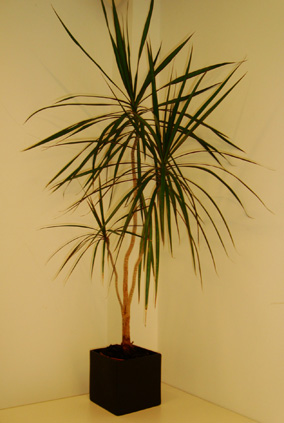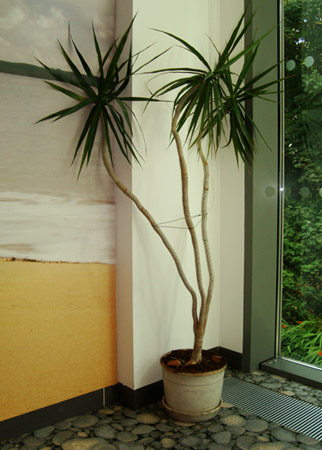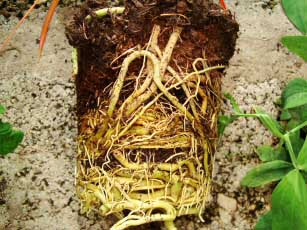





 Dracaena Marginata or the Madagascar Dragon Tree is just one of many houseplants belonging to the Dracaena Group. The common name is a combination of its native origin, "Madagascar" and its more famous cousin Dracaena Draco (meaning Dragon) well known for its tendency to ooze red blood like resin when cut giving it an "alive" quality. Dracaena Marginata does not have the red resin, but that's families and long lasting reputations for you!
Dracaena Marginata or the Madagascar Dragon Tree is just one of many houseplants belonging to the Dracaena Group. The common name is a combination of its native origin, "Madagascar" and its more famous cousin Dracaena Draco (meaning Dragon) well known for its tendency to ooze red blood like resin when cut giving it an "alive" quality. Dracaena Marginata does not have the red resin, but that's families and long lasting reputations for you!
Like the rest of the Dracaena varieties grown indoors the Dragon Tree does have a few drawbacks, but when compared side by side the Marginata remains slender and looks good even when quite tall, it can also support itself without any help from you. Arguably the easiest to look after and perhaps the most popular today. Starting to live in our homes in the 1960's, the Dragon Tree cleans the air and is especially adapt at filtering out xylene and trichloroethylene it also comes in four main varieties and cultivars.

D. marginata
The original Dragon tree.The leaves have a narrow red purple like banding along the edges, with the central parts being a darker green (top left).
D. marginata 'tricolor'
Tricolor is the same as the original Marginata except it has three colours in its leaves. A band of yellow separates the light green from the edged red stripes, producing an overall greenish-gold effect (middle left).
D. marginata 'colorama'
This is the most modern cultivar, with the same growth pattern as the original (although perhaps a little slower) with the difference between the two being seen once more in the leaves. It mirrors the tricolor with the three colours except the red bands on the outside edges are much more prominent, creating an overall reddish or pinkish look (bottom left).
D. marginata 'tarzan'
Unlike the previous three, this easily stands out as quite different. While the leaves are the same colour as the basic Dracaena Marginata they are quite bit tougher and wider, laid out by the plant in an almost spiky ball shape (or perhaps they look like the end of a Dragon's tail) at the very top of each stem or cane. New leaves emerge pointing upwards, as they grow and are gradually replaced by newer leaves they start pointing sideways, before finishing off by pointing downwards. These downward facing leaves then yellow up and drop off, in this way the canes get longer and longer and the "balls" are able to "travel" (shown below).

Light
Light shade is best for your Dragon Tree plant. For example actually sitting on a North facing window ledge, close to an East / West facing window or some distance away from a South facing one. The leaves will scorch if it's too bright, and if too dark the replacement leaves will be very small and limp looking.
Watering
Keep the soil moist at all times (never soggy). Cut back the watering in Winter but even then the soil shouldn't be allowed to dry out completely.
Humidity
Reasonable humidity is required. Often not achievable in the average home so consider misting the leaves from time to time especially if the air is quite dry, plus the misting will help remove any dust settling on the leaves.
Feeding
Regular feeding in Spring and Summer. Sparsely in Autumn / Fall. None in Winter.
Temperature
No lower than 10°C / 50°F. Ideal growth range is between 16°C - 24°C / 60°F - 75°F.
Repotting
You only need to repot when the roots are are very congested and the plant is obviously suffering as a consequence.  Unfortunately the Dragon Tree roots grows exceptionally fast so by this definition you may end up doing this twice a year! Instead we would advising being a little cruel and only repotting every two years.
Unfortunately the Dragon Tree roots grows exceptionally fast so by this definition you may end up doing this twice a year! Instead we would advising being a little cruel and only repotting every two years.
On occasion you may find the large tap roots start to "coil" around and around the pot causing the root ball to rise up out of the container making things very unstable. If this happens conservatively cut back some of the large thick tap roots and reposition what's left to remove the "coil" effect.
Propagation
There are three main ways to propagate an older Dragon Tree (excluding air layering which none of us have ever had success with), and typically you can do all three methods at once to create multiple plants. In time the canes of your plant will become leggy as the leaf area shifts higher and higher up the plant which means you can:
Speed of Growth
Dragon Trees are quite slow growing compared to other houseplants, however in Spring and early Summer they will have fast spurts of growth.
Copyright © www.100flowers.win Botanic Garden All Rights Reserved